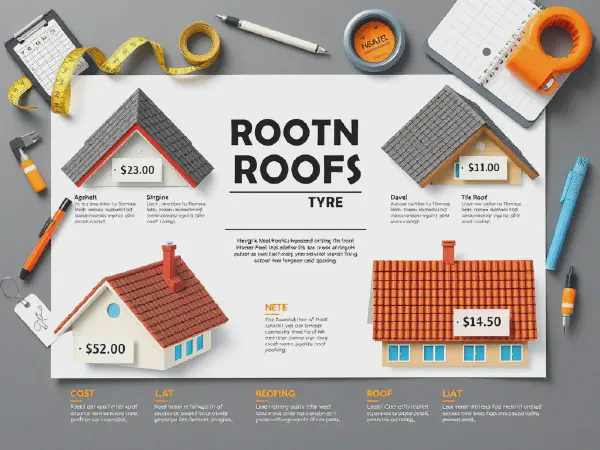Essential Guide to Roof Replacement: Costs, Types, and Tips

The Ultimate Guide to Roof Replacement
Roof replacement is an essential home maintenance task that ensures your property is protected from the elements. A worn-out or damaged roof can lead to significant issues such as leaks, mold, and structural damage. Therefore, understanding the roof replacement process and knowing when to replace your roof is crucial for every homeowner.
The roof is one of the most important components of a home, providing protection against weather conditions while contributing to its overall aesthetic appeal. Regular inspections and timely roof replacement can extend the life of a roof, prevent costly repairs, and maintain the value of your home. Furthermore, selecting the right materials and a qualified contractor can make a significant difference in the outcome of your roofing project.
In this guide, we will explore various types of roof replacement materials, the process involved in roof replacement, cost factors to consider, signs that indicate you need a roof replacement, and the benefits of investing in a new roof. Understanding these aspects will equip you with the knowledge needed to make informed decisions regarding your roofing needs.
Whether you are facing the need for an urgent roof replacement due to damage or you're considering an upgrade for aesthetic reasons, this article will provide valuable insights to help you through the process. From selecting materials to understanding labor costs, we will cover everything you need to know about roof replacement.
For reliable and efficient roof repairs narre warren, professional services can significantly enhance the lifespan of your roof.
By investing time in understanding roof replacement, you’ll not only protect your investment but also enhance your home’s value and comfort. Let’s delve into the various types of roof replacement materials available in the market today.
Types of Roof Replacement Materials
Asphalt shingles are one of the most popular roofing materials due to their affordability and ease of installation. Pros include a wide variety of styles and colors, while cons include a shorter lifespan compared to other materials. Asphalt shingles typically last 15-30 years and are prone to algae growth in humid climates, requiring regular maintenance.
Metal roofing is known for its long-lasting benefits, with a lifespan of up to 50 years or more. It is highly durable, fire-resistant, and reflective, contributing to energy efficiency. However, metal roofs can be more expensive upfront and may require special installation techniques.
Tile roofing provides both aesthetic appeal and durability, making it a popular choice in warmer climates. Clay or concrete tiles can last over 50 years and are excellent at resisting fire and harsh weather. On the downside, tile roofs can be heavy, requiring reinforced structures to support their weight.
Investing in quality commercial roofing melbourne ensures long-lasting durability and protection for your property.
Wood shakes offer a natural look and excellent insulation properties, making them an appealing option for those seeking a rustic charm. However, wood roofs require regular maintenance and are susceptible to rot and insect damage, limiting their lifespan to around 30 years.
Synthetic roofing materials are an innovation in roofing options, often composed of rubber, plastic, or polymer. They can mimic the look of traditional materials while providing increased durability and lower maintenance requirements. They're also lightweight and resistant to mold and algae growth, though they may come at a higher cost.
Roof Replacement Process
The first step in the roof replacement process is inspection and assessment. Homeowners should check for visible signs of damage, such as missing shingles, leaks, and water stains. A professional inspection can also uncover underlying issues that may not be immediately apparent, ensuring you address all problems in the replacement process.
Choosing a roofer requires careful consideration. Homeowners should seek referrals, check reviews, and verify credentials. It's essential to select a licensed and insured contractor who offers warranties on their work and understands the specific needs of your roofing project.
Preparation for roof replacement involves clearing the area around the home, removing any obstacles, and often includes obtaining permits. Homeowners should also prepare for noise and disruptions during the installation process, and it’s wise to communicate with neighbors about the ongoing work.
During installation, expect a meticulous process that can take a few days to complete. Roofers will typically tear off the old roofing material, conduct any necessary repairs to the roof structure, and install underlayment before placing the new roofing material.
After installation, ongoing maintenance is essential to ensure the longevity of your new roof. Regular inspections, cleaning gutters, and promptly addressing any issues that arise can help maintain your roof’s condition and prevent costly repairs in the future.
Cost Factors in Roof Replacement
The cost of roof replacement varies based on the materials chosen. Asphalt shingles are generally the most affordable option, ranging from $90 to $100 per square, while metal roofing can be priced at $300 to $900 per square. Tile and synthetic materials often fall in the higher price range, potentially exceeding $1,000 per square.
Labor costs can range widely, often comprising 60% of the total roofing project expense. Labor costs depend on the complexity of the installation, the roofer's experience, and regional market rates. Homeowners should obtain multiple quotes to ensure a competitive price for quality work.
Hidden costs may arise during roof replacement, such as unexpected structural repairs, disposal fees for old roofing materials, and additional features like skylights or ventilation systems. It's important to have a contingency budget to address these potential issues.
Homeowner’s insurance may cover part of the roof replacement costs, especially if the replacement is due to damage from a covered event. Homeowners should review their insurance policy and communicate with their agent to understand coverage details and claims processes.
Financing options are available for homeowners, including personal loans, home equity loans, or payment plans through roofing contractors. It’s essential to compare interest rates and terms to find the most manageable financing option for your roofing project.
Signs You Need a Roof Replacement
Indicators that your roof may need replacement include visible signs of leakage, such as stains on ceilings, water spots, and mold growth. Any evidence of moisture intrusion can lead to serious issues and should be addressed promptly.
The age of your roof is a critical factor; most roofs last between 20-30 years, depending on materials. If your roof is nearing the end of its expected lifespan, it’s wise to consider a replacement even if no immediate damage is visible.
Shingle damage, including curling, cracked, or missing shingles, along with granule loss in gutters, are clear signs that a roof may need replacing. Monitoring these conditions can help prevent further damage to your home.
Moss and mold growth can trap moisture on the roof’s surface, leading to rot and deterioration. If you notice extensive growth, it may be time for a replacement to protect the underlying structure.
Structural issues such as sagging or visible damage to the roof decking can pose serious safety hazards. If you identify these problems, immediate action is essential to address them, potentially requiring a complete roof replacement.
Benefits of Roof Replacement
A new roof can significantly increase your home’s value—an excellent return on investment for homeowners looking to sell. An updated, high-quality roof can also attract buyers and facilitate a faster sale.
Replacing your roof can lead to improved energy efficiency through better insulation and ventilation, potentially resulting in lower energy costs over time. Energy-efficient roofing materials can also qualify for tax credits or rebates in some regions.
A new roof enhances curb appeal, updating your home’s aesthetics, and allowing you to showcase your personal style with a variety of materials and colors available. An attractive roof can contribute to your home’s overall appearance and neighborhood appeal.
Most new roofing materials come with warranties that cover defects and long-term performance, providing homeowners peace of mind and protection against unexpected expenses related to roof issues.
Additionally, a new roof can ensure compliance with current building codes and safety regulations, protecting homeowners and occupants from potential hazards.
